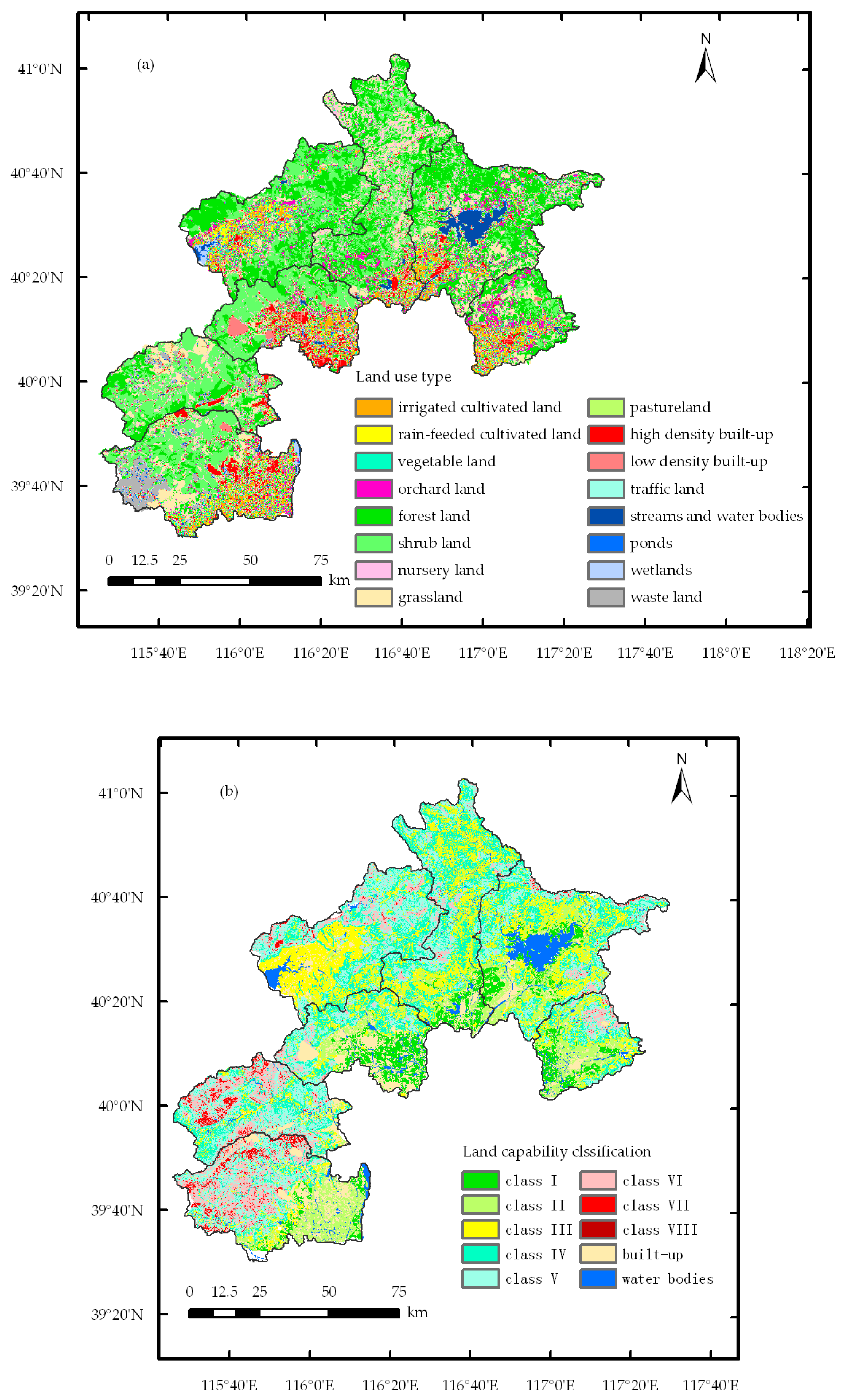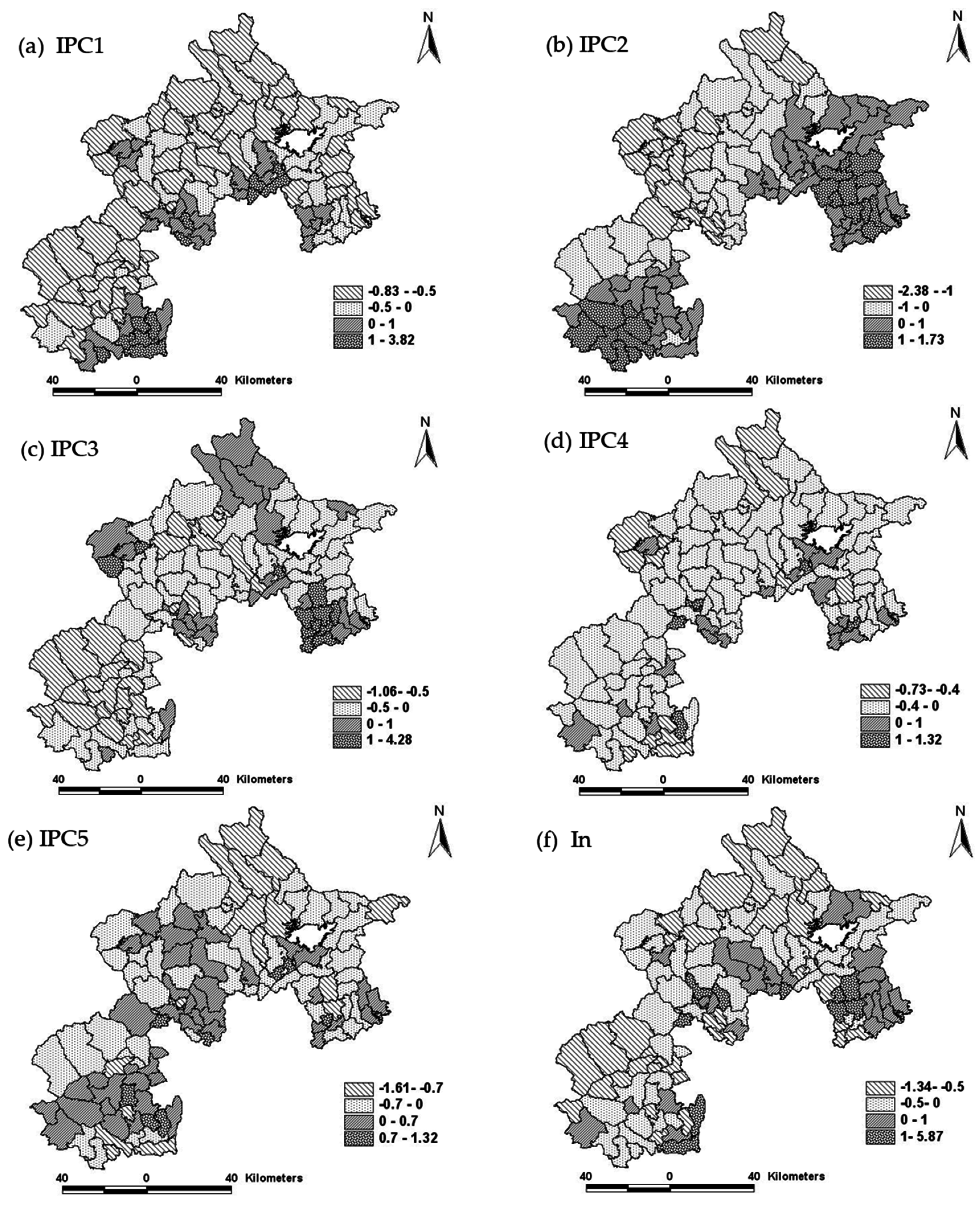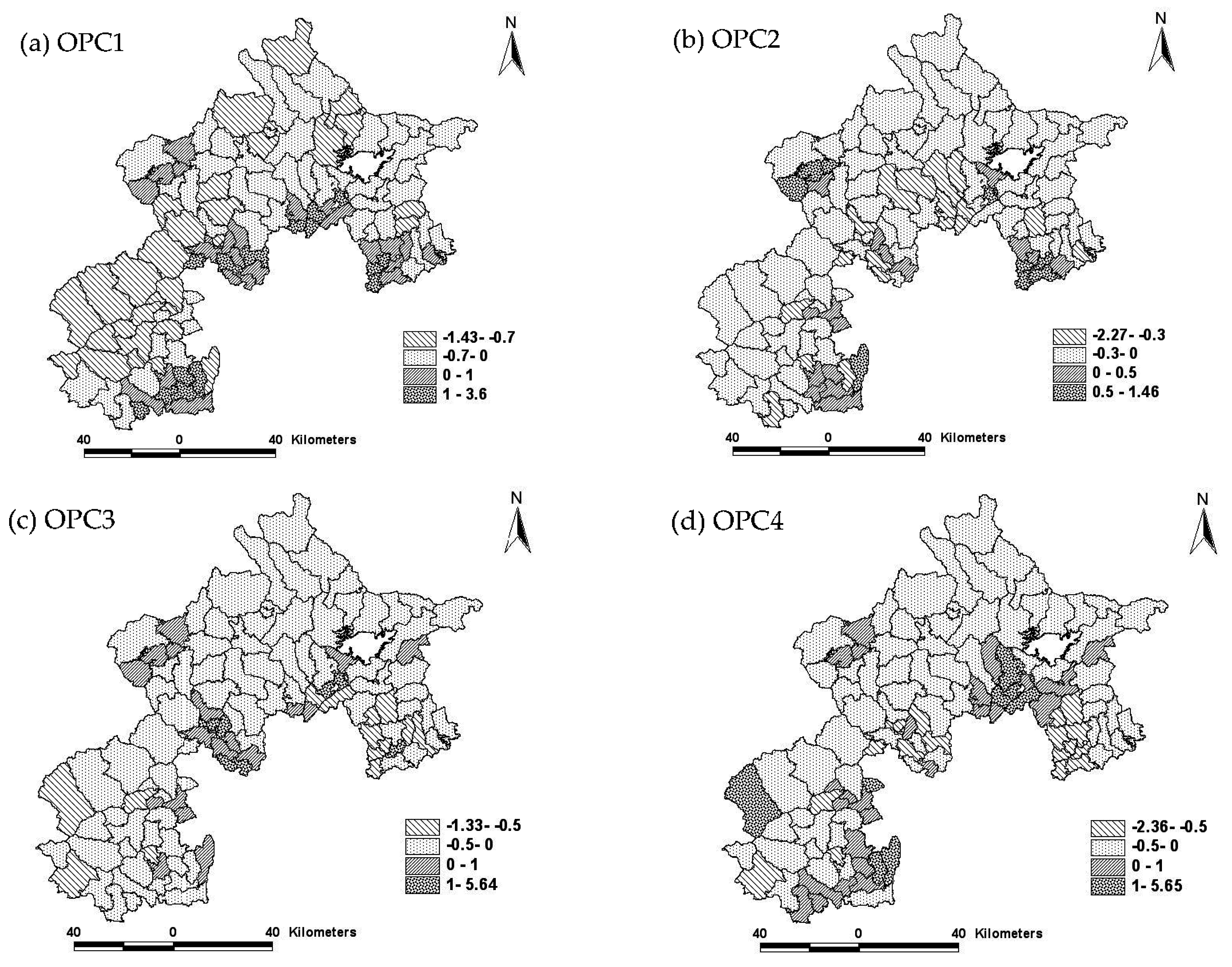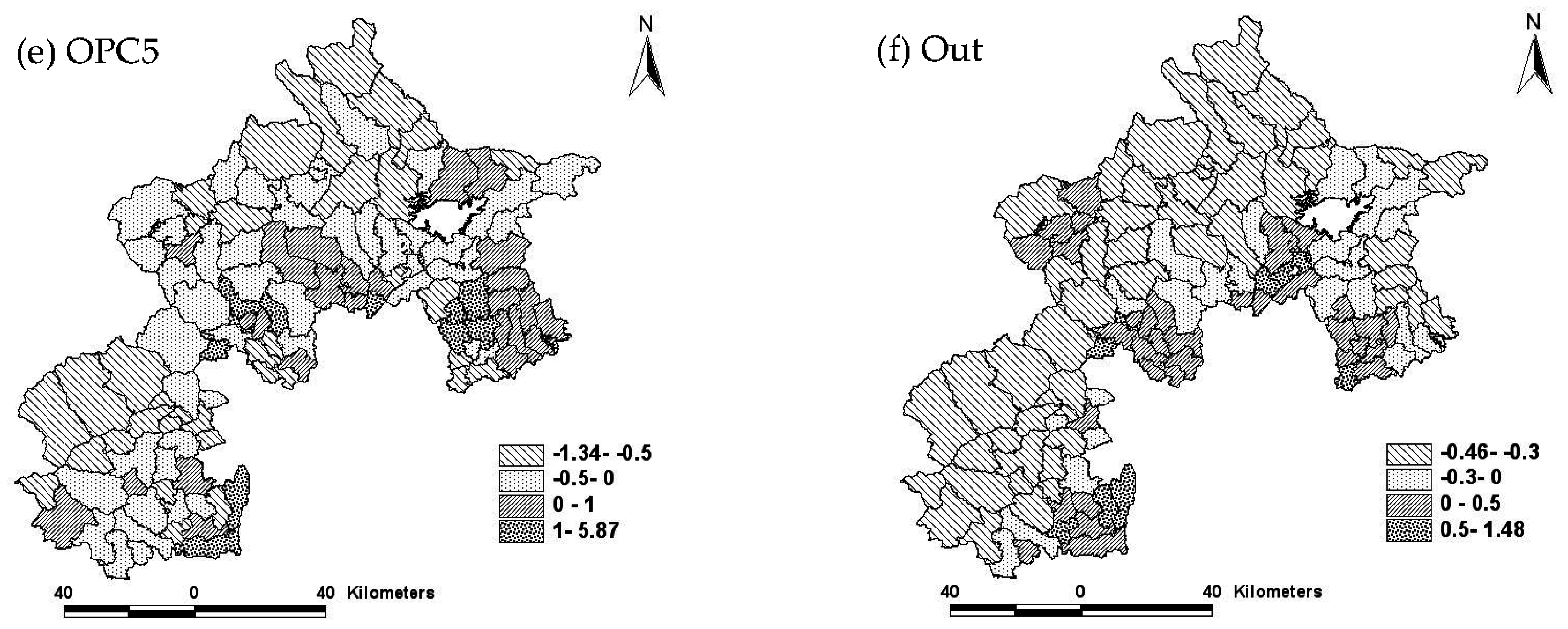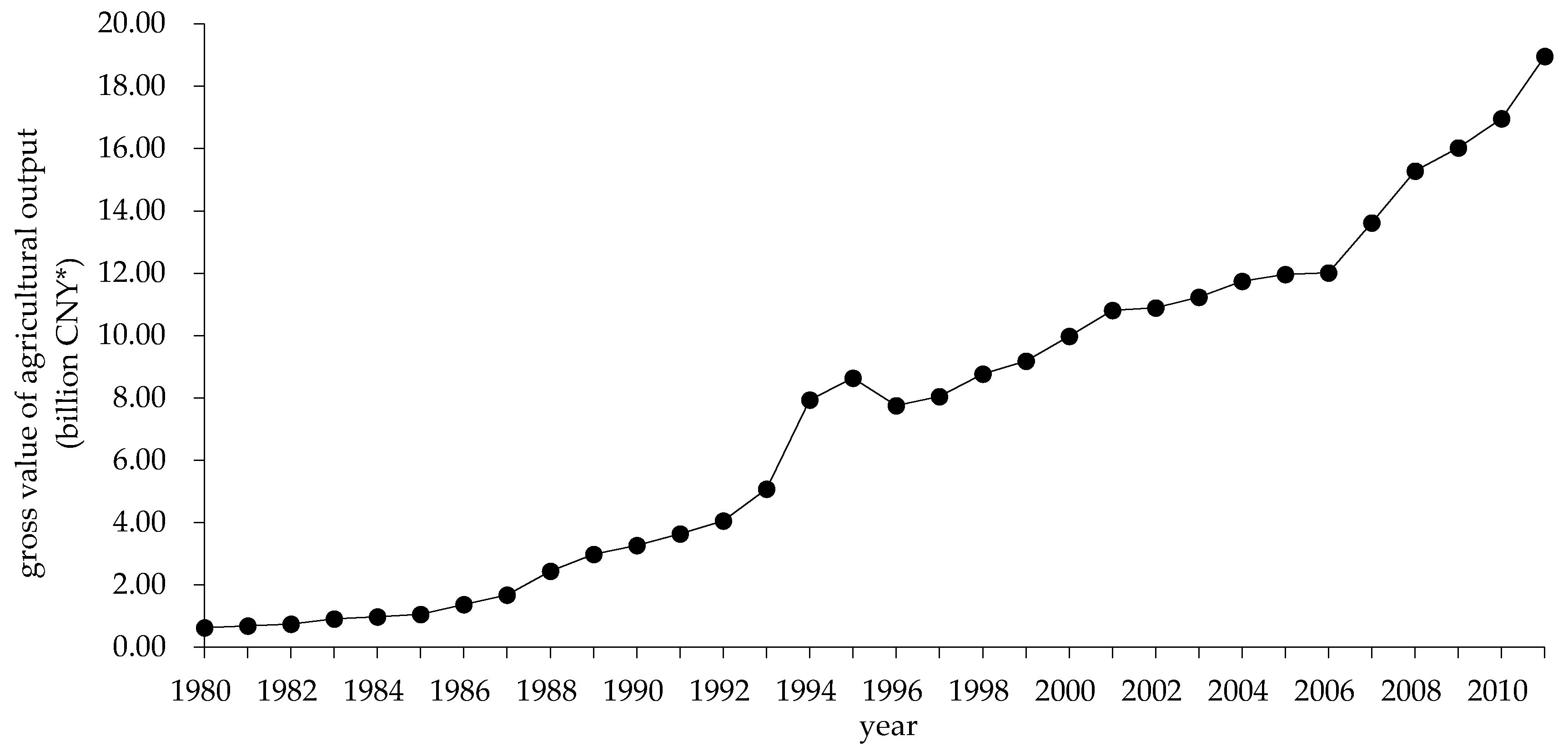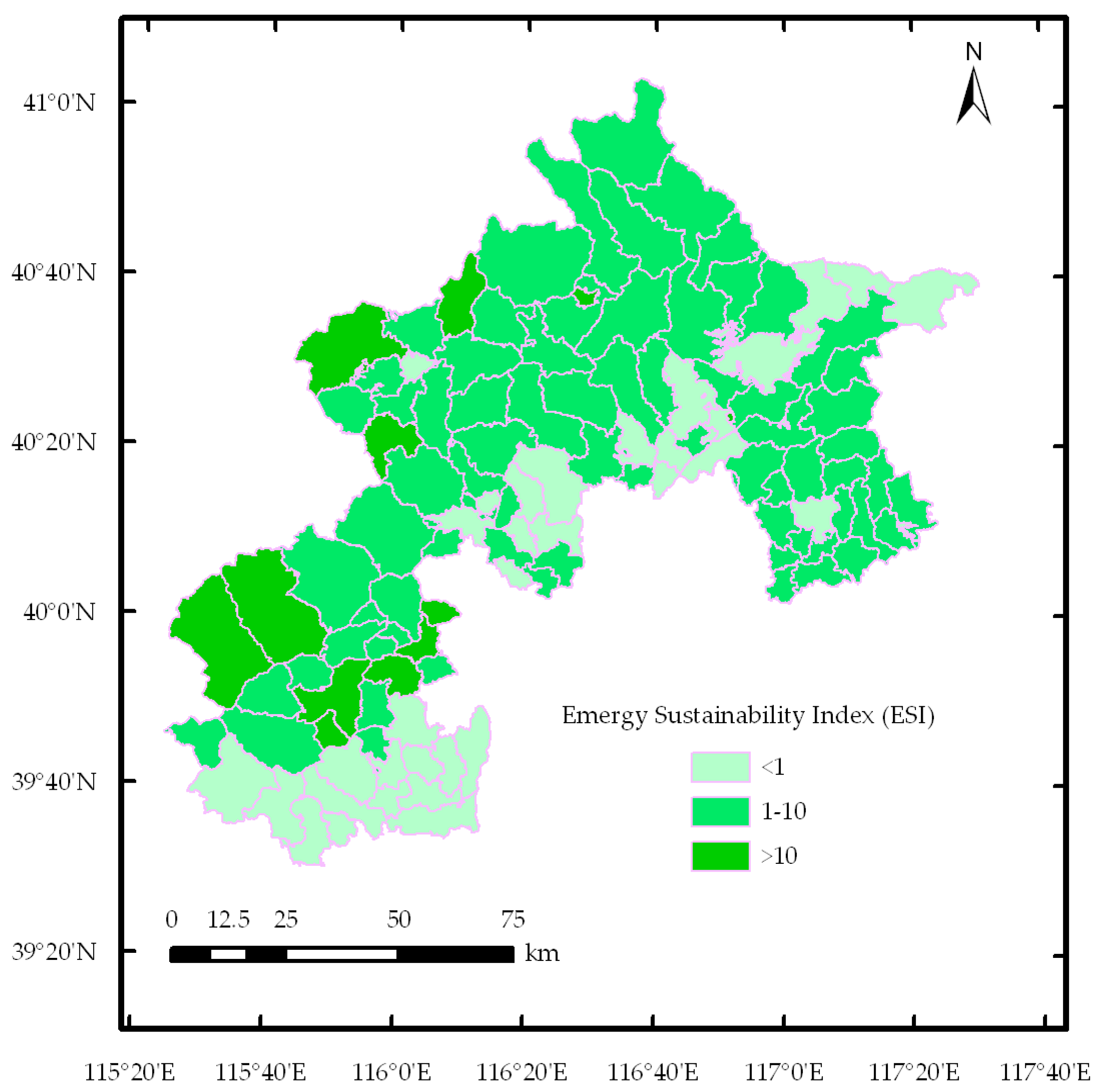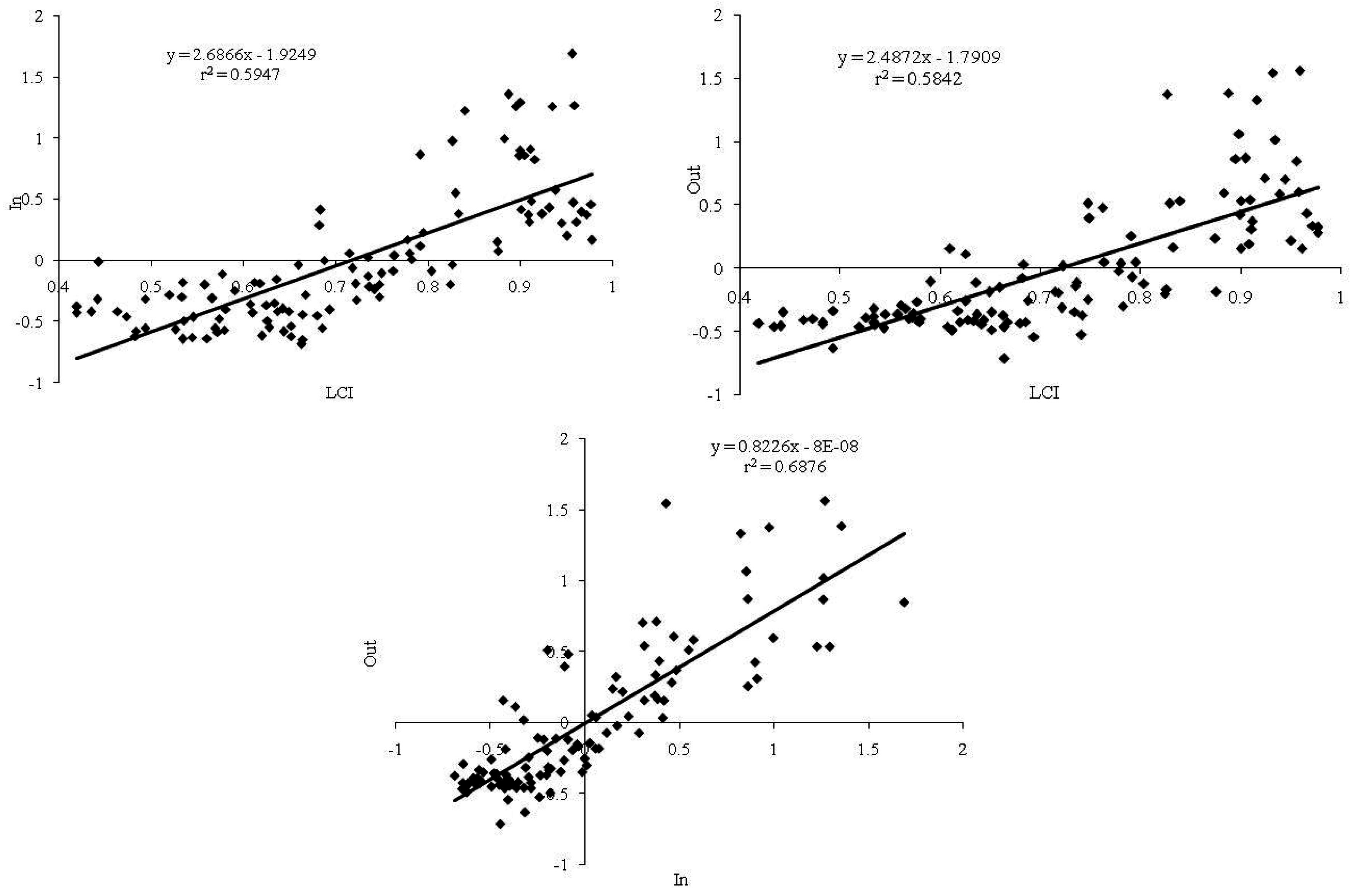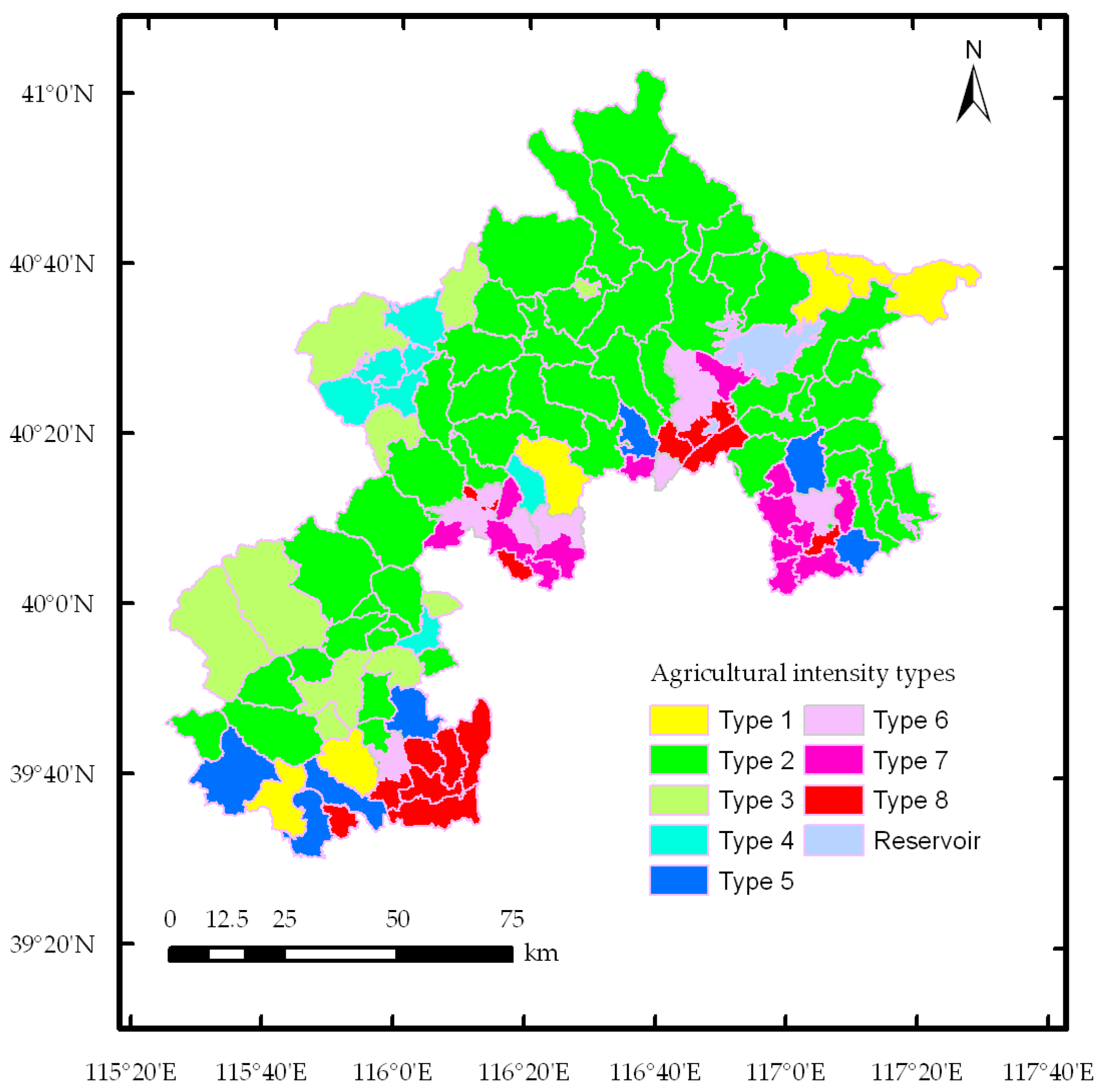1. Introduction
Land use and land cover change has affected the structure and function of ecosystems in different ways [
1] and is central to the sustainable development debate [
2]. Whilst most previous land use and land cover change research was focused on land cover conversions, such as deforestation and urbanization, more subtle processes leading to a modification of land cover deserves more attention. In the research of land use and land cover change, land cover conversion is defined as the complete replacement of one cover type by another, and land cover modification is referred to as more subtle changes that affect the character of the land cover without changing its overall classification [
3]. Land cover modification is frequently caused by changes in the management of agricultural land use including, e.g., changes in levels of inputs and the effect of this on profitability, or the periodicity of complex land use trajectories, e.g., fallow cycles, rotation systems, or secondary forest regrowth [
2].
As the population grows and dietary habits change, future demand for agricultural products will increase over the coming decades. The two basic options for this are the expansion of the land area under agricultural production, and increases of output per unit area in agriculture. Most of the related growth in agricultural production will have to rely on increases of output per unit area in agriculture rather than on the limited land expansion. Such increased output on currently used land is commonly described by the broadly accepted, but ambiguously defined, notion of ‘land use intensification’. In addition, land use intensity is the degree of yield amplification, which is related to changes in levels of inputs and outputs. When land use intensity changes, land cover modification occurs. Land use intensification is one of the most significant forms of land cover modification, with dramatic increases in agricultural production being the main feature. With the increased attention to processes of land cover modification, we should especially pay more attention to land use intensification and intensity. Land use intensification and intensity research would be helpful for providing a better understanding of the complex relationships between people and land resources management, and additional sustainable land resource maintenance.
Beginning at least with von Thünen in 1842, agricultural intensity (viewed in terms of production or yield per unit area and time) has long been regarded as a key concept in numerous explanations of agricultural growth and change [
3]. Until now, many researchers have defined and quantified the terms ‘land-use intensification’ and ‘land use intensity’. The concept of intensification in land use often, although not exclusively, refers to agriculture. Brookfield [
4] describes intensification as being ‘in relation to constant land, the substitution of labor, capital or technology for land, in any combination, so as to obtain higher long-term production from the same area’. Kates et al. [
5] and Netting [
6] use the formulation that intensification is ‘a process of increasing the utilization or productivity of land currently under production, and it contrasts with expansion, that is, the extension of land under cultivation’. Shriar [
7] uses the formulation that ‘agricultural intensification is a process of raising land productivity over time through increases in inputs of one form or another on a per unit area basis’ and measures agricultural intensity based on agrotechnologies, practices, and their degrees of use by farmers by assigning a weight to each input activity with some subjectivity. Kerr and Cihlar [
8] used a principal components analysis (PCA) to integrate the major material inputs and by-product outputs for measuring land use intensity to assess the potential for pollution in agricultural areas. Herzog et al. [
9] proposed intensity indicators of fertilizer input, livestock density, and pesticide input that affect the environment in terms of biodiversity and water quality, and developed an overall intensity index by normalizing the selected intensity indicators to explain land use intensity at the landscape level. Research over the last decade has used material flow and input-output to assess the environmental impacts of systems, products, and services, as well as land use systems [
10,
11]; for example, human appropriation of net primary production (HANPP) was used as the indicator of land use intensity to measure the pressure of human use of land in a defined territory by Wrbka et al. [
12]. In China, the study of land use intensity has been relatively simple and has primarily expressed regional land use intensity based on the characteristics of various land use types, without considering input or output [
13,
14].
Currently, the description of land use intensification/intensity is diverse, and is associated with a lack of measurable criteria. Comparing all of these definitions and measures, we find that intensification/intensity is mostly measured by purchased economic inputs, such as labor, fertilizers, pesticides, mechanical equipment, and some other industrial products. Changes in productivity due to environmental inputs, such as sunlight, rain, and soil, are generally excluded. Agriculture operates at the interface between nature and human economy and combines natural resources and economic inputs to produce food [
15]. Intensive agricultural methods reply more on resources purchased from the economy, while less intensive and indigenous methods typically reply more on natural inputs. Hence, considering natural and economic inputs and agricultural outputs together as intensity indices can provide a holistic measure of agricultural land use intensity. Such an approach is also helpful in understanding the relationship between the inputs and outputs regarding the sustainability of an agricultural system.
Since most types of agriculture depend on a combination of natural and economic inputs, it is necessary to account for both in equivalent terms when comparing the agricultural resource use and further characterizing agricultural land use intensity. Emergy analysis, which evaluates system components on a common basis, is a promising tool to evaluate agricultural resource use and production. The emergy, which was proposed by Odum for system analysis, accounting, and diagnosis, was defined as the available energy of one kind previously used up directly and indirectly to make a service or product, usually quantified in solar energy equivalents and expressed as
solar emJoules (sej) [
16]. The ratio of emergy required to make a product or service is defined as the tansformity, and the corresponding solar emjoules emergy of a product or service is calculated by multiplying units of energy by transformity. Using this technique, natural and economic contributions required to produce agricultural yields can be quantified and compared on a common basis of solar emergy-joules. Emergy analysis has been used to evaluate the sustainability of agricultural methods in Australia, Sweden, Italy, Thailand, and China, etc.
Additionally, more work is needed to assess the agricultural land use intensity effect on the sustainability of an agricultural system. From a sustainability point of view, the agricultural land use intensity should match land quality with there being a high ratio of output to input, minimal imports, and minimal environmental load. A land capability classification system was established by the Soil Conservation Service of the United States of America that is general, simple, and easy to understand. It has, thus, been widely used throughout the world for land quality evaluations. There are eight classes designated by roman numerals, from I–VIII. Increasing class number indicates a lower capability, and the classes indicate the location, amount, and general suitability of soils for agricultural use and the risk of land degradation. In relation to an agro-ecosystem, an emergy sustainability index (ESI), as one of emergy indices, was developed by Ulgiati et al. [
17], Brown and Ulgiati [
18], and Ulgiati and Brown [
19], and the ESI considers both ecological and economic compatibility [
20]. As pointed out by Ulgiati and Brown [
19], a higher index means that an economy is more reliant on renewable energy sources and minimizes imports and environmental load.
The agricultural system in Beijing has played an increasingly important role in areas such as services, the economy, ecology, and tourism, because of the population increase and urban sprawl of Beijing. However, environmental damage caused by agriculture, especially high-intensity industrialized agriculture, has greatly increased. Moreover, land use changes in the Beijing mountainous region have caused many land-related problems, such as water pollution, soil contamination, and air pollution [
21], and reduced the productivity and sustainability of agricultural systems. It is important to derive suitable land use intensity “thresholds” as guidelines for planners and managers to reconcile agricultural and environmental economic objectives. Hence, an improved understanding of land use intensity characteristics and their relationship with socio-economic conditions in the Beijing mountainous region is vital for Beijing’s sustainable development. However, few studies have quantitatively evaluated the land use intensity of the Beijing mountainous region. This paper seeks to develop a statistical index of land use intensity for the Beijing mountainous region and improve the understanding of the area’s structures for land use monitoring and classification.
The objective of this study is to measure agricultural land use intensity in the Beijing mountainous region while considering the input and output of an agricultural system, and to assess the relationship of agricultural land use intensity, land capability, and an emergy sustainability index indicating the effect on the sustainability of an agriculture system.
2. Materials and Methods
2.1. Study Areas
The Beijing mountains region is between 115°24′ and 117°30′E longitude and 39°38′ and 41°05′N latitude and located in the west, north, and northeast of Beijing. There are five suburban districts and two counties, which contain 112 towns, and they account for 62% of the municipal total area (
Figure 1). The elevation within the mountain zone ranges from 80–2303 m above mean sea level, and nearly half the area has slopes greater than 15°. The area has a temperate continental monsoonal climate with an annual average temperature of 11.8 °C (average maximum 26 °C in July and average minimum −5 °C in January). The annual average temperature difference is 30.4 °C, and the daily average temperature difference is 11.4 °C. Temperatures change significantly with elevation in the region, decreasing on an average by 0.6 °C per 100 m rise in elevation. The mean annual precipitation in the area is approximately 566 mm, approximately 60% of which is in July and August. The annual average evaporation is approximately 1761 mm. The area is the source of five large rivers, the Yongding, Chaobai, Beiyun, Jiyun, and Daqing. The annual average runoff is approximately 1.8 × 10
9 m
3 but this has decreased to 1.3 × 10
9 m
3 at the end of the last century as a result of climate and land use/cover changes [
22].
2.2. Emergy Analysis
Each kind of available energy has its emergy with different units expressed, for example, solar emjoule, coal emjoule, electrical emjoule. Actually, the biosphere is usually considered driven by solar energy and most kinds of available energy are derived from solar energy directly or indirectly. Therefore, solar insolation emergy is used as a common measure in most applications. The solar emergy of products and services is calculated by multiplying units of energy by emergy per energy ratios (transformities), units of mass (i.e., grams of corn) by emergy per mass ratios (specific emergy), and dollars by emergy per unit money. During the past four decades, Odum and his collaborators have calculated transformities for various products and services. There are detailed references for emergy algebra and evaluation [
16,
17,
18,
19].
In emergy analysis, inputs to the agro-ecosystem might be categorized into four types: free renewable local resources (RR), such as sunlight, rain, and wind; free non-renewable local resources (NR), soil erosion, for instance; non-renewable purchased industrial subsidiary inputs (NP), such as purchased chemical fertilizers and electricity; and renewable purchased organic inputs (RP), such as labor and oganic manure. Yields of agriculture productions (Y) mainly include the outputs of farming, husbandry, fishery, and forestry, such as crops, vegetables, fruits, meats, forest logging, etc. As most of the agriculture productions are harvested annually, one year is reasonably taken as the time cycle for the agricultural system emergy analysis.
According to the view of emergy analysis, we selected fourteen and twelve variables to characterize agricultural input and output in the Beijing mountainous area (
Table 1), respectively. The analysis was performed on the town scale because the agricultural input and output information derived from census data are aggregated and officially reported at this scale, and the town is also the smallest administrative unit for planning and management purpose in China. Based on the town scale, the analysis results would better link with policies and their assessment. The agricultural input and output data for 112 towns in the year of 2013 were derived from the Statistical Yearbook of five districts and two counties [
23]. After quantifying annual inputs and outputs for every town in raw units (joules, grams), these values were multiplied by their respective transformities to calculate the quantity of solar emergy required for each agricultural input and output. The used transformities and their reference sources are listed in
Table 1. To make these towns easily comparable, the solar emergy of each agricultural input and output were normalized for agricultural land area, and these values were quantified in solar emjoules per hectare (sej·ha
−1).
2.3. Agriculture Input and Output Intensity Indices (In and Out)
Land use intensity can be defined in a number of ways. In this study, we define it to be a combination of major agricultural inputs and outputs that are directly measured in emergy analysis, i.e., agriculture input intensity and agriculture output intensity. We used the solar emergy data of agricultural input and output, respectively, as inputs for a principal components analysis (PCA), from which we saved the components with eigenvalues exceeding 1. PCA reduces variables to a smaller number of factors that maximize the variation in common to all variables but that are completely uncorrelated with one another (i.e., are orthogonal in n-space). While PCA creates severe difficulties when used to describe the relationship between independent and dependent variables, it remains very effective for reducing the dimensionality of independent datasets. The reasons for using this statistical method were to reduce the number of input and output variables into an “index” of input intensity and output intensity. The Anderson-Rubin method [
28], which ensures the orthogonality of the factors, was used to calculate the component scores in PCA. The scores have a mean of 0, a standard deviation of 1, and are uncorrelated. To further combine different input and output intensities, the selected components were integrated as one index (In or Out) using the following equation with their eigenvalues as weights:
where
is the integrated index In or Out, and
is the eigenvalue of an extracted principal component
.
Before PCA, the Kolmogorov-Smirnov (K-S) statistics were used to test the goodness-of-fit of the data to a log-normal distribution. According to the K-S test, all of the variables are log-normally distributed with 95% or higher confidence. To examine the suitability of the data for PCA, Kaiser-Meyer-Olkin (KMO) and Bartlett’s test were performed. KMO is a measure of sampling adequacy that indicates the proportion of variance which is common variance, i.e., which might be caused by underlying factors. A high value (close to 1) generally indicates that PCA may be useful, which is the case in this study: KMO = 0.76. Bartlett’s test of sphericity indicates whether correlation matrix is an identity matrix, which would indicate that variables are unrelated. The significance level which is 0 in this study (less than 0.05) indicates that there are significant relationships among variables.
2.4. Land Capability Overall Index (LCI) and Emergy Sustainability Index (ESI)
A land capability classification map of the study areas was created using a land use map derived from image processing and interpretation of Landsat-8, based on the effects of combinations of climate and permanent soil characteristics on the productive capacity, limitations of use, and risks of land degradation, particularly water erosion and fertilization degradation (
Figure 2). The land capability classification map contained grid data with 30m resolution. The relative coverage area for each land capability class in the study areas is presented in
Table 2. The highest land quality (class I–class II) was found on the plains close to urban areas and accounted for only 16.47% of the whole study area, a moderate land quality (class III–class V) was mainly found in the foothills and basin of the Beijing mountainous region and accounted for 59.03% of the study area, and the poorest land quality was found for the moderate mountain terrain and accounted for 11.56% of the study area.
In this study, the data analyses were performed at the town level. Thus, the LCI for each town, which reflects the regional land resources quality, were calculated through the following equation:
where
is the percentage of the total area occupied by the land capability class
at the town level and
is the weight for land capability class
, which is obtained using its potential productivity and local expert knowledge (
Table 2). As such, the LCI is an area-weighted average to reflect the overall status of land quality, and the higher the LCI, the higher the land potential.
The emergy sustainability index (ESI), that is one of basic emergy indices, was calculated as [
19]:
where
EYR is the emergy yield ratio, and
ELR is the environmental load ratio which expresses the use of environment services by a system, indicating a load on the environment.
Y,
NP,
RP,
NR,
RR are explained in
Table 1. The larger the ESI, the higher the sustainability of a system.
2.5. Data Analyses
The correlation analysis and regression analysis have been widely used in land use research. In this study, correlation analysis was conducted for the indices LCI, In, Out, and ESI to verify whether they were reasonably dependent on one another. A regression analysis was applied to examine the relationships between the LCI, In, Out, and ESI.
Cluster analysis is a group of multivariate techniques whose primary purpose is to assemble objects based on the characteristics they possess. Cluster analysis classifies objects, so that each object is similar to the others in the cluster with respect to a predetermined selection criterion. The resulting cluster of objects should then exhibit high internal (within-cluster) homogeneity and high external (between clusters) heterogeneity. K-means clustering is the most common and fastest approach, which aims to partition n observations into k clusters in which each observation belongs to the cluster with the nearest mean. When the number of clusters is fixed to k, k-means clustering gives a formal definition as an optimization problem: finding the k cluster centers and assigning the objects to the nearest cluster center, such that the squared distances from the cluster are minimized. In this study, the LCI, In, Out, and ESI were used as independent variables in a cluster analysis (k-means algorithm) in order to aggregate towns into zones of similar agricultural land use intensity. The k value minimizing the sum of squares due to error (SSE) was identified as the number of agricultural land use intensity types through trying different k values. The purpose of using the k-means algorithm was to collapse the number of towns into fewer groups, which could then be analyzed in more detail.
The above statistical analyses were performed with the SPSS 13.0 software (International Business Machines Corporation, Armonk, NY, USA).
4. Conclusions
Land use intensity has become a hot topic in land use and land cover change research, and it often, although not exclusively, refers to agriculture. Using the Beijing mountainous region as a case study, the spatial distributions of agricultural land use intensity were determined using an emergy analysis through PCA and k-means clustering methods. The extracted principal components could help determine the agricultural input and output structure of Beijing mountainous region. The study indicated that the emergy methodology could integrate analytical data into a common unit basis, making the results more usable. Therefore, characterizing agricultural land use intensity based on an ecological assessment method provides an overall assessment of regional land use intensity.
Correlation and regression analyses were used to determine the relationship between land capability, agricultural input intensity, and agricultural output intensity. The correlation patterns and regression modeling obtained from this study can help to understand land use intensity. In the future, research efforts will be on going to discover the further relationship among agricultural input intensity, agricultural output intensity, land capability, and agricultural system sustainability. In the assessment of the eight agricultural land use intensities, the agricultural land use intensity should be suitable to the land capability, and the agricultural output intensity should be high with low agricultural input intensity to maintain the sustainability of an agricultural system.
The results of this study demonstrate the usefulness of a tool for characterizing and assessing agricultural land use intensity in the Beijing mountainous region. It can be used to help urban planners, managers, and decision-makers monitor, adjust, and control the sustainable development of agricultural land use in the Beijing mountainous region.

